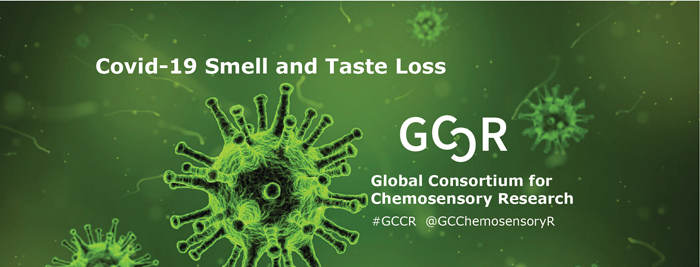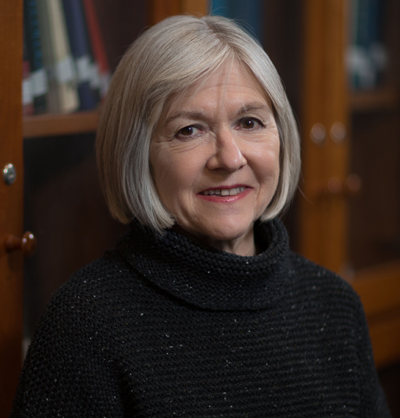Things are changing quickly during the pandemic of 2020, even though time may seem to move as slowly as molasses in January while working from home. Over the last few weeks, much has been written about the connection between smell loss and COVID-19 infection. Take these news articles in the New York Times, NPR, and this Q&A with Dr. Nancy Rawson in Perfumer & Flavorist Magazine.
But social media is where the action is.
This discourse really took off for chemosensory scientists over the weekend of March 14-15. Monell was involved from the start and is now part of a global consortium of taste and smell researchers called the Global Consortium for Chemosensory Research (GCCR). This is a grassroots effort by scientists, clinicians, and patient advocates to study anosmia (loss of smell) and ageusia (loss of taste) as early warning signs of COVID-19 infection.

GCCR was literally born on social media (join in the conversation on Twitter and Facebook). A website is soon to follow.
“More than 50 researchers worldwide have been on an epic 150-plus message email thread this weekend to formulate a questionnaire to evaluate the effects of COVID-19 on smell and taste,” wrote Monell Associate Director Danielle Reed, PhD, to a group of Monell investigators on Sunday March 22th.
GCCR’s goal is to bring together researchers across the world to provide reliable information on the smell and taste aspects of the pandemic based on current evidence-based data gathered by clinicians and research scientists. Ultimately, GCCR aims to learn if there are differences in sensory symptoms in people with COVID-19 infection compared with other types of viral and bacterial infections.
Viral upper respiratory infections – even the common cold – can damage the primary smell receptors, neurons in the olfactory epithelium of the nose, causing smell problems long after the infection has cleared. “However, we know very little about the nature of the viruses that can cause these losses or the circumstances under which they are most likely to occur,” said Monell Member Beverly Cowart, PhD.
Although there is no established treatment for this form of loss, there is some evidence that the regenerative process is aided by regular, intermittent exposure to odors, with efforts to identify smells, which is referred to as “smell training.” This appears to be most effective if begun early. Monell has hosted several smell training sessions with Chrissi Kelly, the founder of AbScent,org, an online community of people who have experienced a loss of smell. Kelly went through the process and has developed several suggestions to improve the efficacy of smell training.
Monell is also holding a panel discussion on April 28th at 1:30 pm on the partnership of patients and scientists in advancing smell loss research. This event was originally scheduled as an in-person/recorded event but has since been moved to an all-remote event. During the panel, two speakers will report on the work Monell is doing with the GCCR, one of whom is Monell Member Pam Dalton, PhD. Please sign up here for this free event.



To prepare for these upcoming meetings, Reed has pulled together the current state of chemosensory data as it pertains to COVID-19 infection:
Losses of smell and to a lesser extent taste are common occurrences during upper respiratory infections1-4. Clinicians and patient reports during the 2019-2020 pandemic indicate that infection with SARS-CoV-2 resulting in COVID19 is associated with disturbances in smell and taste perception5-8, and these observations are supported by early surveys of infected patients9-11. On March 20, 2020 the Ear, Nose, and Throat Society of the UK and the British Rhinological Society recommended that people with sudden onset anosmia should self-isolate based upon presumed CoV-2 infection12. And on March 22, 2020 the American Academy of Otolaryngology made a similar recommendation13. However, there is no reason at the current time to suspect that people with pre-pandemic smell loss have increased risk of being SARS-CoV-2 carriers.
The extent to which loss of chemosensory function is a sensitive and specific indication of COVID19 infection in the current pandemic is one of the big questions the GCCR is asking and will certainly be a hot topic in the weeks to come.
1. Seiden, A.M., Postviral olfactory loss. Otolaryngol Clin North Am, 2004. 37(6): p. 1159-66.
2. Pellegrino, R., et al., Investigation of chemosensitivity during and after an acute cold. Int Forum Allergy Rhinol, 2017. 7(2): p. 185-191.
3. Cowart, B.J., et al., Clinical disorders of smell and taste. Occup Med, 1997. 12(3): p. 465-83.
4. Hummel, T., et al., Position paper on olfactory dysfunction. Rhinol Suppl, 2017. 54(26): p. 1-30.
5. Stone, J. There’s An Unexpected Loss Of Smell And Taste In Coronavirus Patients. 2020 [cited 2020 March 28th]; Available from: https://www.forbes.com/sites/judystone/2020/03/20/theres-an-unexpected-loss-of-smell-and-taste-in-coronavirus-patients/#39252ef55101.
6. Rabin, R. Loss of sense of smell may be peculiar clue to coronavirus infection. 2020 [cited 2020 March 28th]; Available from: https://www.nytimes.com/2020/03/22/health/coronavirus-symptoms-smell-taste.html.
7. Gale, J. NBA Player’s Loss of Smell Highlights Unusual Marker of Covid-19. 2020 [cited 2020 March 28th]; Available from: https://www.bloomberg.com/news/articles/2020-03-23/nba-player-s-loss-of-smell-highlights-unusual-marker-of-covid-19?utm_campaign=news&utm_medium=bd&utm_source=applenews.
8. Bienkov, A. If you’ve lost your sense of smell or taste, you could be a ‘hidden carrier’ of the coronavirus. 2020; Available from: https://www.businessinsider.com/coronavirus-symptoms-loss-of-smell-taste-covid-19-anosmia-hyposmia-2020-3.
9. Bagheri, S.H.R., et al., Coincidence of COVID-19 epidemic and olfactory dysfunction outbreak. medRxiv, 2020.
10. Mao, L., et al., Neurological Manifestations of Hospitalized Patients with COVID-19 in Wuhan, China: a retrospective case series study. medRxiv, 2020: p. 2020.02.22.20026500.
11. Giacomelli, A., et al., Self-reported olfactory and taste disorders in SARS-CoV-2 patients: a cross-sectional study. Clinical Infectious Diseases, 2020.
12. Hopkins, C. and N. Kumar. Loss of sense of smell as marker of COVID-19 infection. 2020 [cited 2020 March 28th]; Available from: https://www.entuk.org/sites/default/files/files/Loss%20of%20sense%20of%20smell%20as%20marker%20of%20COVID.pdf.
13. American Academy of Otolaryngology – Head and Neck Surgery. Anosmia, Hyposmia, and Dysgeusia Symptoms of Coronavirus Disease. 2020 [cited 2020 March 28th]; Available from: <https://www.entnet.org/content/coronavirus-disease-2019-resources.
